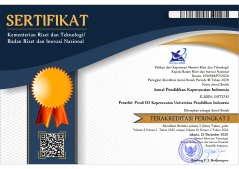Usability Of “DFU Application” For Diabetic Foot Ulcer Prevention
Abstract
Introduction: The development of smart detection software may help reduce the number of decubitus ulcer infections by enabling early identification and management. Ensuring the usability and effectiveness of such technology is essential before widespread adoption. Objective: This study aimed to explore prospective users’ perceptions of the mobile app for detecting diabetic foot ulcer (DFU) infection, focusing on its usefulness, ease of use, and overall user satisfaction. Methods: The usability of the DFU app was assessed by experienced users. The evaluation included perceived usefulness, ease of use, and overall satisfaction. Standardized tools such as the System Usability Scale (SUS) and a specific app rating scale were used to collect user feedback. Results: The DFU app received usability ratings ranging from 0.50 to 0.88. The lowest rating was for performance quality (Mean = 0.50, SD = 0.12), while the highest was for integrity (Mean = 0.88, SD = 0.07). The overall usability score, as measured by SUS, was considered acceptable (Mean = 78.4, SD = 6.83). Most users reported no significant issues with using the app, except for difficulty understanding the language used in the interface, which was rated as a serious usability issue with a severity score of 3. Conclusions: Users perceived the DFU app as useful and efficient, particularly in detecting the risk of infection. Despite a noted language comprehension issue, the app demonstrated good overall usability and has the potential to support early intervention for decubitus ulcer prevention.
Keywords
Full Text:
PDFReferences
Armstrong, D. G., Boulton, A. J. M., & Bus, S. A. (2017). Diabetic foot ulcers and their recurrence. New England Journal of Medicine, 376(24), 2367–2375.
Azevedo, R. F. L., Varzino, M., Steinman, E., & Rogers, W. A. (2025). Evaluating Effectiveness of mHealth Apps for Older Adults With Diabetes: Meta-Analysis of Randomized Controlled Trials. Journal of Medical Internet Research, 27, e65855.
Erande, P., Ray Mohanty, I., & Rai, S. (2023). Development and user acceptability testing of healthy heart mobile application–a tool for cardiovascular risk modification among patients with type 2 diabetes mellitus. Journal of Basic and Clinical Physiology and Pharmacology, 34(6), 773–790.
Hsu, J., & Yang, M. (2019). Strengthening exercises for foot deformities in diabetes. Journal of Diabetes Science and Technology, 13(7), 345–354.
Jahromi, M. K., Ramezanli, S., & Taheri, L. (2014). Effectiveness of diabetes self-management education on quality of life in diabetic elderly females. Global Journal of Health Science, 7(1), 10.
Lazzarini, P. A., Hurn, S. E., Fernando, M. E., Jen, S. R., & Kuys, S. S. (2022). Effectiveness of interventions to improve foot-ankle functionality in people with diabetic foot complications: A systematic review. Diabetes Therapy, 11(5), 1155–1166. https://doi.org/https://doi.org/ 10.1007/s13300-020-00852-3.
Li, J., He, L., & Wei, J. (2021). Efficacy of aerobic and resistance exercise on vascular health and wound healing in diabetic patients. Journal of Diabetes Science and Technology, 15(6), 1162–1171. https://doi.org/https://doi.org/10.1177/19322968211028469.
McLeod, J., Anderson, T., & Brown, S. (2020). Redistribution of plantar pressure through foot exercises. Journal of Diabetic Complications, 34(7), 125–138.
National Institute of Health Research and Development, I. M. of H. (2018). National report on basic health research, RISKESDAS 2018. Ministry of Health Jakarta.
Ogedengbe, T. O. (2023). Content development for a tool to assess the preparedness of employment environment to welcome people with visual impairment.
Onu, D. U., Ifeagwazi, C. M., & Prince, O. A. (2022). Social support buffers the impacts of Diabetes distress on health-related quality of life among type 2 diabetic patients. Journal of Health Psychology, 27(10), 2305–2317.
Otis, M., Zhu, J., Mustafa-Kutana, S. N., Bernier, A. V., Shum, J. M., Dupre, A. A. S., & Wang, M. L. (2020). Testing usability and feasibility of a mobile educator tool for pediatric diabetes self-management: mixed methods pilot study. JMIR formative research, 4(5), e16262.
Pratiwi, L. D., Haryanto, J., & Wahyudi, A. S. (2023). The Effect of Foot Self Care and Diabetes Self-management Mobile Application in Preventing Foot Ulcer Recurrence: A Systematic Review Study. Malaysian Journal of Medicine & Health Sciences, 19.
Rosyid, F. N., Supratman, S., Kristinawati, B., & Kurnia, D. A. (2020). Kadar glukosa darah puasa dan dihubungkan dengan kualitas hidup pada pasien ulkus kaki diabetik. Jurnal Keperawatan Silampari, 3(2), 500–509.
Toledo Peral, C. L., Ramos Becerril, F. J., Vega Martinez, G., Vera Hernandez, A., Leija Salas, L., & Gutierrez Martinez, J. (2018). An Application for Skin Macules Characterization Based on a 3‐Stage Image‐Processing Algorithm for Patients with Diabetes. Journal of Healthcare Engineering, 2018(1), 9397105.
Zhou, J., Ding, S., Xu, Y., & Pan, H. (2025). Effects of digital intelligent interventions on self-management of patients with diabetic foot: systematic review. Journal of Medical Internet Research, 27, e64400.
DOI: https://doi.org/10.17509/jpki.v11i1.81809
Refbacks
- There are currently no refbacks.
Jurnal Pendidikan Keperawatan Indonesia(JPKI) published by Indonesia University of Education. JPKI is licensed under a Creative Commons Attribution-ShareAlike 4.0 International License.
Office :
Nursing Department. FPOK UPI.
229, Dr. Setiabudhi Street. Bandung 40154
West Java , Indonesia
E-mail : jpki@upi.edu

_.png)
_.png)
_.png)











